历史
Hartley Institution
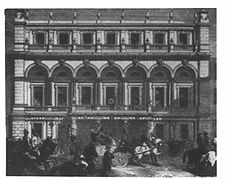
The arrival of Prime Minister Lord Palmerston for the opening of the Hartley Institute on the 15th October 1862
The University of Southampton has its origin as the Hartley Institution which was formed in 1862 from a benefaction by Henry Robertson Hartley (1777–1850). Hartley had inherited a fortune from two generations of successful wine merchants. At his death in 1850, he bequest £103,000 to the Southampton Corporation for the study and advancement of the sciences in his property on the Southampton's High Street, in the city centre.
| “ |
...employ the interest, dividends and annual proceeds in such a manner as best promote the study and advancement of the sciences of Natural History, Astronomy, Antiquities, Classical and Oriental Literature in the town, such as by forming a Public Library, Botanic Gardens, Observatory, and collections of objects with the above sciences. |
” |
|
—Bequest to the Corporation of Southampton of Henry Robertson Hartley estate.
|
Hartley was an eccentric straggler, who had little liking of the new age docks and railways in Southampton. He did not desire to create a college for many (as formed at similar time in other English industrial towns and commercial ports) but a cultural centre for Southampton's intellectual elite. After lengthy legal challenges to the Bequest, and a public debate as to how best interpret the language of his Will, the Southampton Coorperation choose to create the Institute (rather than a more widely accessible college, that some public figures had lobbied for).
On 15 October 1862 the Hartley Institute was opened by the Prime Minister Lord Palmerston in a major civic occasion which exceeded in splendor anything that anyone in the town could remember. After initial years of financial struggle, the Hartley Institute became the Hartley College in 1883. This move was followed by increasing numbers of students, teaching staff, an expansion of the facilities and registered lodgings for students.
University College

Front of the Hartley Library, constructed in the 1930's after the move to Highfield Campus, with the support of private donors.
In 1902, the Hartley College became the Hartley University College, a degree awarding branch of the University of London. This was after inspection of the teaching and finances by the University College Grants Committee, and donations from Council members (including William Darwin the then Treasurer). An increase in student numbers in the following years motivated fund raising efforts to move the college to greenfield land around Back Lane (now University Road) in the Highfield area of Southampton. On the 20th June 1914, Viscount Haldane opened the new site of the renamed Southampton University College. However, the outbreak of the First World War six weeks later meant no lectures could take place there, as the buildings were handed over by the college authorities for use as a military hospital. In order to cope with the volume of casualties, wooden huts were erected at the rear of the building. These were donated to university by the War Office after the end of fighting, in time for the transfer from the high street premises in 1920. At this time, Highfield Hall, a former country house and overlooking Southampton Common, for which a lease had earlier been secured, commenced use as a halls of residence for female students. South Hill, on what is now the Glen Eyre Halls Complex was also acquired, along with South Stoneham House to house male students.
Further expansions through the 1920s and 30s was made possible through private donors, such as the two daughters of Edward Turner Sims for the construction of the University library, and from the people of Southampton, enabling new buildings on both sides of University Road. During World War II the university suffered damage in the Southampton Blitz with bombs landing on the campus and its halls of residence. The college decided against evacuation, instead expanding its Engineering Department, School of Navigation and developing a new School of Radio Telegraphy. Halls of residence were also used to house Polish, French and American troops. After the war, departments such as Electronics grew under the influence of Erich Zepler and the Institute of Sound and Vibration was established.
University
On 29 April 1952, in the early weeks of the reign of HM Queen Elizabeth II, a Royal Charter was granted to the University of Southampton, which enabled the institution to award its own degrees. Six faculties were created: Arts, Science, Engineering, Economics, Education and Law. The first University of Southampton degrees were awarded on 4 July 1953, following the appointment of the Duke of Wellington as Chancellor of the University. Student and staff number grew throughout the next couple of decades as a response to the Robbins Report. The campus also grew significantly, when in July 1961 the university was given the approval to acquire some 200 houses on or near the campus by the Borough Council. In addition, more faculties and departments were founded, including Medicine and Oceanography (despite the discouragement of Sir John Wolfenden, the chairman of the University Grants Committee). Student accommodation was expanded throughout the 1960s and 70s with the acquisition of Chilworth manor and new buildings at the Glen Eyre and Montefiore complexes.
In 1981 a crisis developed when the University Grants Committee announced, as part of nationwide cutbacks, a series of reductions in the funding of the university. In order to eliminate the expected losses, the budgets and deficits subcommittee proposed reducing staff numbers. This proposal was met with demonstrations on campus and was later reworked (to reduce the redundancies and reallocate the reductions in faculties funding) after being rejected by the university Senate.
By the mid 1980s through to the 90s the university looked to expand with new buildings on the Highfield campus, developing the Chilworth Manor site into a science park and conference venue, opening the National Oceanographic Centre at a dockside location and purchasing new land from the City Council for the Arts Faculty and sports fields (at Avenue Campus and Wide Lane, respectively).
Research University
Under the leadership of then Vice Chancellor, Sir Howard Newby the university became more focused in encouraging and investment in more and better quality research. In the mid 90s, the university gained two new campuses, as the Winchester School of Art and La Sainte Union College became part of the university. A new school for Nursing and Midwifery was also created and went on to provide training for NHS professionals in central-southern England. This involved a huge increase in student numbers and the establishment of sub-campuses in Basingstoke, Winchester, Portsmouth and Newport, Isle of Wight.
In the autumn of 1997 the university experienced Britain's worst outbreak of meningitis, with the death of three students. The university responded to the crises by organizing a mass vaccination programme, and later took the ground breaking decision to offer all new students vaccinations.
The University celebrated its Golden Jubilee on 22 January 2002. By this time, Southampton had research income that represented over half of the total income, which remains one of the highest proportions of income derived from research activities of British Universities. In recent years a number of new landmark buildings have been added as part of the estates development. These have included a new buildings for the School of Electronics and Computer Science and the Optoelectronics Research Centre (ORC), (whose original building was destroyed in a fire in 2005), a new Sports Hall and Institute of Developmental Sciences (on the Southampton General Hospital site).
校园
The University has five campuses located throughout the city of Southampton alongside the School of Art based in nearby Winchester.
Highfield 校园
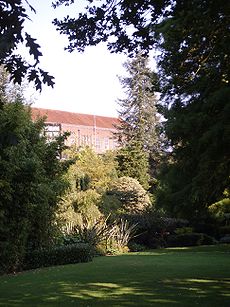
Gardens on Highfield Campus
Main article: Highfield Campus
The University's main campus is located in the residential area of Highfield. Opened on the 20th June 1914 the site was initially used as a military hospital during World War I. The campus grew gradually, mainly consisting of detailed red brick buildings (such as the Hartley library and West building of the Students' Union) designed by Sir Giles Gilbert Scott. In 1956 Sir Basil Spence was commissioned to prepare a masterplan of the campus for the foreseeable future. This included incorporating the University Road, that split the 59-acre campus in two and the quarry of Sir Sidney Kimber's brickyard that itself was split by a stream. Unable to remove the road and the private houses along it, Spence designed many of the buildings facing away from it, using contemporary designs working in concrete, glass and mosaic. During recent decades new buildings were added that contravened the master plan of Spence, such as the Synthetic Chemistry Building and Mountbatten Building (the latter of which was destroyed by fire in 2005).
A new masterplan for the Highfield campus was drawn up in 1998 by Rick Mather who proposed that the University Road should become a tree lined boulevard backed by white-rendered buildings. He also contributed some of the newer buildings such as the Zepler and Gower Buildings. In 1991 the Highfield Planning Group was formed within the university under the chairmanship of Tim Holt. This led to the development of new buildings such as the Jubilee Sports Hall, Student Services Building and the Institute of Sound and Vibration Research. In addition, existing buildings, such as the Hartley Library were extensively renovated and extended.
The campus retains an area of parkland in which are scattered 20th century sculptures by Barbara Hepworth, Justin Knowles, Nick Pope and John Edwards. It also houses the John Hansard Gallery, the Nuffield Theatre and the Turner Sims Concert Hall.
Avenue 校园
Main article: Avenue Campus
The Avenue Campus site was previously home to the Southampton Tramsheds and Richard Taunton's College. It was purchased by the university in December 1993 from Southampton city council for £2 million. Today it houses most of the school of Humanities including the Centre for Language Study. In 2006 a new purpose-designed building for Archaeology was completed.
Boldrewood 校园
Main article: Boldrewood Campus
Boldrewood is the Biomedical Sciences campus of the University located a short distance from the Highfield campus. It is used as a non-hospital base for the School of Medicine and home to a research facility for the Biological Sciences
In April 2006, the University announced plans to develop a 'professional campus' on the Boldrewood site, relocating its present occupants to Highfield campus in 2007. The site is intended to house the Marine services division of Lloyd's Register who have announced a strategic alliance with the University. The campus will also be the new home of the School of Management.
National Oceanography Centre
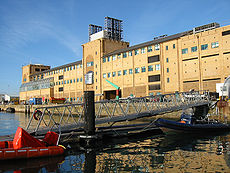
National Oceanography Centre
Main article: National Oceanography Centre
The National Oceanography Centre, Southampton (NOCS) was a purpose-built, joint venture between the University and the Natural Environment Research Council (NERC). Opened in 1996 by Prince Philip, NOCS is located near the Ocean Village development in the dock area of Southampton.
The NOCS comprises the School of Ocean and Earth Sciences which operates alongside four NERC research divisions. The NOCS is also the base for the purpose-built research vessels RRS Discovery and RRS James Cook (and formerly RRS Charles Darwin).
Southampton General Hospital
Main article: Southampton General Hospital
The university's presence at the general hospital dates to 1971, when Southampton (along with Nottingham and Leicester universities) became the first new Schools of Medicine to be founded in the United Kingdom in the twentieth century. As a teaching hospital, it is used by a range of undergraduate and postgraduate medical students, research academics and clinicians. Originally based in the South Academic Block, the university's presence has been expanded to include several other buildings which are home to six different research departments.
Winchester School of Art
Main article: Winchester School of Art
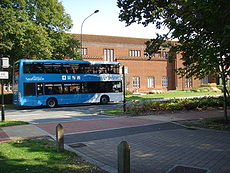
Uni-link doubledecker bus passing through Highfield Campus
The Winchester School of Art was integrated within the University of Southampton in 1996. This original school premises were purpose build in the 1960s. New buildings have been designed to house the subsequent expansion of student numbers, and new facilities for fashion design, a digital media campus and also to include the internationally respected Textile Conservation Centre which moved its premises from Hampton Court Palace in 1999.
Uni-link
Main article: Uni-link
The Uni-link bus service was created in 1998 by the University. Four routes operate that connect the university campuses and halls of residence located throughout the city for both students at the university and general public.
Organisation
Governance
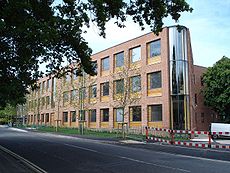
The Professional Services Building, responsible for the effective delivery of all non-academic activities within the University in collaboration with Schools and Faculties.
Responsibility for running the University is held formally by the Chancellor, currently Sir John Parker and led at the executive level by the Vice-Chancellor, currently Don Nutbeam. The key bodies in the University governance structure are the Council, Court and Senate.
The Council is the governing body of the University. It is ultimately responsible for the overall planning and management of the University. The Council is also responsible for ensuring that the funding made available to the University by the Higher Education Funding Council for England is used as prescribed. The Council is composed of members from 5 different classes, namely (1) officers; (2) twelve members appointed by the Council; (3) six members appointed by the Senate; (4) one member of the non-teaching staff; (5) the President of the Students’ Union.
The University Court provides a forum for consultation with the local and regional community, to help promote public awareness of the University and to attract and maintain goodwill. The Court is composed of some 190 members, comprising representatives of the University, which includes members of Council, Deans of the Faculties, Heads of Academic Schools, members of staff, students and graduates; representatives of local authorities and of schools and colleges in the region; members of the UK and European parliaments; and representatives of other local societies and bodies.
The Senate is the University's primary academic authority, including the direction and regulation of education and examinations, the award of degrees, and the promotion of research. The Senate has approximately 150 members, including the Deputy Vice-Chancellors/Pro Vice-Chancellors, the Deans and Associate Deans of the Faculties, the Heads of the academic Schools and Research Centres, representatives from the academic staff in each School, representatives of the research staff and those administrative groups most closely associated with educational activities, and representatives of the Students' Union. The Senate is Chaired by the Vice-Chancellor.
Faculties and schools
The University is made up of a number of schools organized into three faculties:
|
Faculty of Engineering, Science and Mathematics
- Engineering Sciences
- Civil Engineering and the Environment
- Chemistry
- Geography
- Electronics and Computer Science
- Mathematics
- Physics and Astronomy
- Ocean and Earth Science
|
Faculty of Law, Arts and Social Sciences
- Arts
- Law
- Humanities (Archaeology, English, Film Studies, History, Music, Modern Languages and Philosophy)
- Social Sciences (Economics, Politics, Sociology and Social Policy, Statistics and Social Work Studies)
- Education
- Management
|
Faculty of Medicine, Health and Life Sciences
- Biological Sciences
- Nursing and Midwifery
- Health Professions and Rehabilitation Sciences
- Psychology
- Health Care
- Medicine
|
|
Libraries and collections
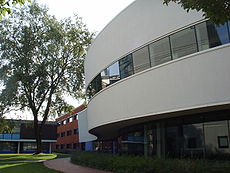
Exterior of the 2005 extension to the Hartley Library
The University of Southampton Library has a presence on each of the university's six campuses, holding more than 1.5 million books and periodicals, some 6,000 in electronic form, besides specialist materials, including more than 6 million manuscripts.
The library contains a number of special collections of rare books and manuscripts. In 1983, the university received the correspondence of Arthur Wellesley, 1st Duke of Wellington. It also houses the Broadlands Archive, including the Palmerston and Mountbatten papers. The library also contains 4,500 volumes of Claude Montefiore's library on Theology and Judaism, the Ford Parliamentary Papers, Frank Perkins' collection of books on agriculture, Sir Samual Gurney-Dixons's Dante collection and the James Parkes Library of Jewish/non-Jewish relations. The library also includes six rare editions of the Divina Commedia; the first of these, the Brescia edition of 1487, is the library's earliest book.
The Hartley library, first built in 1935, has expanded successively to house special collection and to meet the growth in student numbers. The latest of these was in 2005, when 3200 m² were added and much of the existing building renovated.
学术
Degrees
Southampton awards a wide range of academic degrees spanning academic degrees for bachelor's in a variety of degrees and master's degrees as well as junior doctorates and higher doctorates. The postnominals awarded are the degree abbreviations used commonly among British universities. The University is part of the Engineering Doctorate scheme, for the award of Eng. D. degrees.
Professional qualifications are also awarded, such as Qualified Teacher Status (QTS). Short courses and professional development courses are run by many of the University’s Academic Schools and Research Centres.
The University works closely with members of the Armed Forces. It provides professional military educators in the British Army to study for a Postgraduate Certificate in Education (PGCE). The University also works with the Royal Navy to provide training and qualifications towards Chartered Engineer status.
League table rankings
| University of Southampton Ranking in league tables |
| Year |
THES - QS World University Rankings |
Academic Ranking of World Universities |
Webometrics Ranking of World Universities |
Times Good University Guide |
Guardian University Guide |
Sunday Times University Guide |
Daily Telegraph |
Independent
Complete University Guide
supported by
PriceWaterHouseCoopers |
| 1993 |
|
|
|
11 |
|
|
|
|
| 1994 |
|
|
|
16 |
|
|
|
|
| 1995 |
|
|
|
22 |
|
|
|
|
| 1996 |
|
|
|
12 |
|
|
|
|
| 1997 |
|
|
|
19 |
|
|
|
|
| 1998 |
|
|
|
21 |
|
17 |
|
|
| 1999 |
|
|
|
22 |
|
20 |
|
|
| 2000 |
|
|
|
26 |
|
18 |
|
|
| 2001 |
|
|
|
26 |
|
20 |
|
|
| 2002 |
|
|
|
37 |
17 |
11 |
16 |
|
| 2003 |
|
153-201 |
|
24 |
20 |
14 |
18 |
|
| 2004 |
|
152-200 |
|
28 |
34 |
17 |
|
|
| 2005 |
206 |
153-203 |
|
25 |
37 |
17 |
|
|
| 2006 |
141 |
151-200 |
|
26 |
36 |
16 |
|
|
| 2007 |
80 |
151-202 |
102 |
22 |
|
16 |
20 |
|
| 2008 |
99 |
152-200 |
110 |
14 |
13 |
12 |
|
20 |
| 2009 |
95 |
152-200 |
74 |
16 |
25 |
|
|
20 |
| 2010 |
|
|
76 |
15 |
22 |
12 |
|
13 |
|
Subject Rankings
| Actuarial Science |
| Civil Engineering |
| Year |
Times Good
University Guide
|
Complete
University Guide
|
Guardian
University Guide
|
| 2006 |
3 |
|
|
| 2007 |
|
|
|
| 2008 |
6 |
6 |
3 |
| 2009 |
|
6 |
10 |
| 2010 |
9 |
9 |
12 |
| Computer Science |
| Year |
Times Good
University Guide
|
Complete
University Guide
|
Guardian
University Guide
|
| 2006 |
7 |
|
2 |
| 2007 |
7 |
|
|
| 2008 |
5 |
8 |
5 |
| 2009 |
5 |
8 |
3 |
| 2010 |
4 |
9 |
4 |
| Electronic & Electrical Engineering |
| Year |
Times Good
University Guide
|
Complete
University Guide
|
Guardian
University Guide
|
| 2006 |
2 |
|
1 |
| 2007 |
2 |
|
|
| 2008 |
2 |
5 |
1 |
| 2009 |
2 |
5 |
16 |
| 2010 |
2 |
2 |
3 |
| Mechanical Engineering |
| Year |
Times Good
University Guide
|
Complete
University Guide
|
Guardian
University Guide
|
| 2006 |
3 |
|
2 |
| 2007 |
3 |
|
|
| 2008 |
4 |
8 |
6 |
| 2009 |
2 |
8 |
3 |
| 2010 |
5 |
5 |
1 |
|
Research
Southampton is a member of the Russell Group, a network of research-led British universities. The university conducts research in most academic disciplines and is home to a number of notable research centres.
Research Institutes
Within the three faculties of the university there are a number of research institutes:
|
Faculty of Engineering, Science and Mathematics
- Hearing and Balance Centre (ISVR)
- Human Factors Research Unit (ISVR)
- Fluid Dynamics and Acoustics Group (ISVR)
- Signal Processing and Control Group (ISVR)
- Transportation Research Group (TRG)
- Centre for Environmental Sciences
- Southampton Regional e-Science Centre
- Computational Engineering and Design Centre
- Lloyd’s Register University Technology Centre
- Luxfer Advanced Technology Centre in Performance of Materials
- GeoData Institute
- Centre for Operational Research, Management Science and Information Systems
- Southampton Statistical Sciences Research Institute
- EPSRC NanoPhotonics Portfolio Centre
- Optoelectronics Research Centre
- National Oceanography Centre
|
Faculty of Law, Arts and Social Sciences
- Centre for the Archaeology of Human Origins
- Centre for Applied Archaeological Analyses
- Centre for Maritime Archaeology
- Centre for Antiquity and the Middle Ages
- Centre for Rhetoric and Cultural Poetics
- Parkes Institute for the Study of Jewish/non-Jewish Relations
- Textile Conservation Centre
- Centre for Contemporary Art Research
- Institute of Maritime Law
- Institute of Criminal Justice
- Centre for Risk Research
- Centre for Research in Accounting,Accountability and Governance
- Centre for Operational Research, Management Science and Information Systems
- Centre for AIDS Research
- Centre for Human Service Technology
- ESRC Centre for Population Change
- ESRC National Centre for Research Methods
- Centre for Applied Social Surveys
|
Faculty of Medicine, Health and Life Sciences
- Centre for Sexual Health Research
- Developmental Brain-Behaviour Unit
- Centre for Research on Self and Identity
- Centre for Behavioural Research,Analysis and Intervention in Developmental Disabilities
- Centre for the Study of Emotion and Motivation
- Institute of Biomolecular Sciences
- Southampton Neurosciences Group
- MRC Epidemiology Resource Centre
- Southampton Cancer Centre
- Life Sciences Interface Forum
- Developmental Origins of Health and Disease
- The Stroke Association Rehabilitation Research Centre
- The Macmillan Research Unit
|
|
The University of Southampton Science Park
In 1983, the Chilworth Science Park was established for companies with connections to the University. The park houses over 50 companies and includes a luxury hotel and conference centre, based in Chilworth Manor. The science park was re-named The University of Southampton Science Park in 2006 .
The university has produced a number of spin-out companies in a range of fields, including oil and gas exploration, pharmaceuticals, nanotechnology and optoelectronics. Southampton has been particularly noted for its effectiveness in producing spin-out companies in comparison with both its UK and US counterparts.
Over 150 businesses are associated with the university through the key partner scheme, allowing collaboration in the research and development of business and Southampton academics.
EPrints
Main article: EPrints
The School of Electronics and Computer Science created the first archiving software (EPrints) to publish its research freely available on the Web. This software is used throughout the university and as an archiving system for many different institutions around the world.
Student life
Students' Union
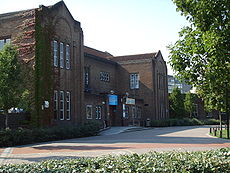
The West Building on Highfield Campus.
The University of Southampton Students' Union (SUSU), is sited in three buildings opposite the Hartley Library. One, the West Building, dates back to the 1940s in a red brick style, complementing the Hartley Library opposite; the main building was built in the 1960s in the Basil Spence masterplan. This was extended with new nightclub and cinema facilities in 2002. The newest building was built during the mid-1990s which includes the recently refurbished Union shop, on the ground floor, and hairdressers and travel agency, both on the first floor. In May 2002 (after numerous attempts going back several years), it chose to disaffiliate itself from the NUS, believed by SUSU to be too bureaucratic. The multiple award winning student radio station, Surge, broadcasts from new studios in the main Union building. The award winning website SUSU.org was created and run by students at the university. A brand new purpose built studio has been constructed for the TV station SUSU.TV. The student newspaper, originally Wessex News, is now published once every three weeks as Wessex Scene following a name change in 1996. Inside the Wessex Scene is an editorially independent entertainment magazine called "The Edge". Events are held in The Cube, the Union's nightclub, "The Bridge", the Union's cocktail bar, and in the Stag's Head, the Union pub. National touring bands play in the Garden Court in the West Building. The current President of the Union for the academic year 2009/2010 is Steve O'Reilly.
Halls of Residences
The university provides accommodation for all first year students who require it and places in residences are further available for international and MSc students. Accommodation may be catered, self catered, have ensuite facilities, a sink in the room, or access to communal bathroom facilities. Each of the halls has a team of wardens who live on-site and ensure students' welfare. Each hall also has a JCR committee that is responsible for the running of social events and representing the residents to the students union and the university via the Students union JCR officer. Some of the halls also have bars which are separately run by the students union and are staffed by current and ex residents.
There are three main complexes of halls of residence. The Glen Eyre Halls Complex lies less than half a mile to the north of Highfield Campus. Set in landscaped surroundings, the complexes houses over 2000 students. These are spread though various buildings, designed and constructed throughout the Universities history. The Wessex Lane Halls complex lies approximately one mile east of the Highfield Campus. Situated next to the gardens of South Stoneham House it houses over 1800 students. Included is Connaught Hall, one of the original halls of residence of the University. The Small Halls accommodate around 1000 students across 7 city locations, within 2 miles of Highfield Campus. The Univerisity also has halls of residence in Winchester for School of Art students, Portsmouth and Basingstoke for School of Nursing and Midwifery students.
|
Glen Eyre Halls Complex
- Chamberlain Hall
- Hartley Grove Courts
- Chancellors' Courts
- New Terrace
- Old Terrace
- South Hill Lodges
- Richard Newitt Courts
- Brunei House
- Beechmount House
- Gower building
|
Wessex Lane Halls Complex
- Connaught Hall
- Montefiore 1
- Montefiore 2
- Montefiore 3
- Montefiore 4
|
Archers Road and Small Halls
- Highfield Hall
- Bencraft Court
- Gateley Hall
- Romero Hall
- Shaftesbury Avenue Apartments
- St. Margaret's House
- Tasman Court
|
Non-Southampton Locations
- Erasmus Park (Winchester School of Art)
- Balmoral House (Portsmouth)
- Victoria Place (Portsmouth)
- Basingstoke North Hampshire Hospital Accommodation
|
|
Sports
The Sports and Recreation (SportsRec) runs the university sports facilities which are based predominately at two locations. The Jubilee Sports Centre, opened in 2004 at a cost of £8.5 million is located on the Highfield Campus. Included within in the centre are a six-lane, 25-metre swimming pool, full gym and sports hall. In addition to its indoor sports facilities, the University completed a £4.3 million re-development of its 73-acre outdoor facilities located at Wide Lane, Eastleigh (near Southampton) in 2007. Within the complex includes flood-lit synthetic turf pitches, tennis courts, and pavilion. The university also runs facilities at the Avenue Campus, National Oceanography Centre and the Boat Hard on the River Itchen.
The university competes in numerous sports in the BUCS South East Conference (after switching from the Western Conference in 2009). A number of elite athletes are supported by the SportsRec through sports bursaries and the UK Government's Talented Athlete Scholarship Scheme (TASS) .
The University Athletic Union was formally established on the 29th November 1929, by the University College council. Versions of the union had existed previously to which many clubs such as Cricket, Association Football, Rugby, Boxing, Gymnastics, Tennis and Boat clubs (all formed before the turn of the 20th century) were members.
Throughout its history the university has had a number successful teams in national student championships.
| National Student Champions from the University of Southampton |
| Year |
Team (Mens) |
Team (Womans) |
| 1936 |
|
Tennis |
| 1958 |
Basketball |
Badminton |
| 1966 |
Cricket |
|
| 1966 |
Squash |
|
| 1968 |
Cricket |
|
| 1968 |
Table Tennis |
|
| 1969 |
Cricket |
Squash |
| 1969 |
Rifle Shooting |
|
| 1969 |
Table Tennis |
|
| 1970 |
Cricket |
Hockey |
| 1970 |
Rifle Shooting |
|
| 1970 |
Table Tennis |
|
| 1971 |
Table Tennis |
|
| 1972 |
Rifle Shooting |
|
| 1974 |
Rifle Shooting |
Tennis |
| 1974 |
Trampolining |
|
| 1975 |
|
Badminton |
| 1975 |
|
Tennis |
| 1976 |
Ten Pin Bowling |
Badminton |
| 1976 |
|
Squash |
| 1977 |
|
Badminton |
| 1977 |
|
Swimming |
| 1979 |
Squash |
Lacrosse |
| 1979 |
Trampolining |
Ten Pin Bowling |
| 1980 |
Squash |
Lacrosse |
| 1980 |
Volleyball |
|
| 1981 |
Volleyball |
|
| 1982 |
|
Fencing |
| 1983 |
Volleyball |
|
| 1984 |
Archery |
|
| 1984 |
Weight Lifting |
|
| 1985 |
Archery |
Volleyball |
| 1985 |
5-a-side |
|
| 1986 |
5-a-side |
Volleyball |
| 1991 |
Archery |
|
| 1991 |
5-a-side |
|
| 1992 |
Archery |
|
| 1995 |
|
Rowing |
| 2000 |
Windsurf |
|
| 2001 |
Windsurf |
|
|
Notable people
Main article: List of University of Southampton people
学术
Academics to work at the university include Sir Tim Berners-Lee, inventor of the World Wide Web, Erich Zepler who made leading contributions to radio receiver development, David Payne who invented EDFA for use in fibre optics cables. Others include Sir Barry Cunliffe, a pioneer of modern British Archaeology, Albie Sachs, former Judge of the Constitutional Court of South Africa and Tim Holt, former President of the Royal Statistical Society and Office for National Statistics
Alumni
Former students of the university include John Denham MP, Secretary of State for Communities and Local Government; Sir John Stevens; former head of the Metropolitan Police Service and Current International Security Advisor to the Prime Minister; Chris Hohn, founder of The Children's Investment Fund Management and Britain's biggest charity donor; Jon Sopel, presenter of The Politics Show and a lead presenter on BBC News 24 and Sir Adrian Fulford, Judge in the International Criminal Court. Other alumni include actor John Nettles, Technical Director for the Red Bull Racing Formula One team Adrian Newey, and musician Brian Eno..
参考文献
- ^ "Annual review & financial statements 2008/09" (Adobe Pdf). University of Southampton. http://www.soton.ac.uk/finance/central/FA2009.pdf. Retrieved 2010-04-18.
- ^ "Table 0a - All students by institution, mode of study, level of study, gender and domicile 2006/07" (Microsoft Excel spreadsheet). Higher Education Statistics Agency. http://www.hesa.ac.uk/dox/dataTables/studentsAndQualifiers/download/institution0607.xls. Retrieved 2008-04-12.
- ^ "Good University Guide Profile: University of Southampton". London: The Times. June 19, 2008. http://www.timesonline.co.uk/tol/life_and_style/education/good_university_guide/article2166726.ece. Retrieved 2009-02-05.
- ^ Times Good University Guide 2008 Retrieved on 2007-08-04
- ^ Guardian University Guide 2008 Retrieved on 2007-08-04
- ^ Sunday Times University Guide 2008 Retrieved on 2008-09-25
- ^ Daily Telegraph University league table (Last Updated: 1:50am BST 30/07/2007) Retrieved on 2007-11-09
- ^ "Times Higher Education top 100 2009". http://www.timeshighereducation.co.uk/hybrid.asp?typeCode=438.
- ^ Mann, John Edgar & Ashton, Peter (1998). Highfield, A Village Remembered. Halsgrove. ISBN 1-874448-91-4.
- ^ Patterson, A. Temple (1962). "Henry Robinson Hartley and the Establishment of the Hartley Institution". The University of Southampton : A Centenary History of the Evolution and Development of the University of Southampton, 1862-1962. Southampton: The Camelot Press Ltd. pp. 9=-24.
- ^ Patterson, A. Temple (1962). "Southampton in the Middle of the Nineteenth Century". The University of Southampton : A Centenary History of the Evolution and Development of the University of Southampton, 1862-1962. Southampton: The Camelot Press Ltd. pp. 1–9.
- ^ Nash, Sally; Martin Sherwood (2002). "Growing Pains". University of Southampton : An Illustrated History. London: James and James. pp. 13–17. ISBN 0907383947.
- ^ Patterson, A. Temple (1962). "Reorganization and Achievement: 1892-1902". The University of Southampton : A Centenary History of the Evolution and Development of the University of Southampton, 1862-1962. Southampton: The Camelot Press Ltd. pp. 89--107.
- ^ Patterson, A. Temple (1962). ""The Old Hartley"". The University of Southampton : A Centenary History of the Evolution and Development of the University of Southampton, 1862-1962. Southampton: The Camelot Press Ltd. pp. 107--138.
- ^ Nash, Sally; Martin Sherwood (2002). "War and the Years After, 1939-52". University of Southampton : An Illustrated History. London: James and James. pp. 44--57. ISBN 0907383947.
- ^ Nash, Sally; Martin Sherwood (2002). "The Pre-Robbins Years, 1952-65". University of Southampton : An Illustrated History. London: James and James. pp. 57–68. ISBN 0907383947.
- ^ Nash, Sally; Martin Sherwood (2002). "Who Pays the Piper, 1979-85". University of Southampton : An Illustrated History. London: James and James. pp. 92--104. ISBN 0907383947.
- ^ Nash, Sally; Martin Sherwood (2002). "Into the Premier League". University of Southampton : An Illustrated History. London: James and James. pp. 116--130. ISBN 0907383947.
- ^ Laurance, Jeremy (Monday, 8 June 1998). "University offers students jab to fight meningitis". London: The Independent. http://www.independent.co.uk/news/university-offers-students-jab-to-fight-meningitis-1163629.html. Retrieved 2009-04-10.
- ^ "Fire destroys top research centre". news.bbc.co.uk. Monday, 31 October 2005. http://news.bbc.co.uk/2/hi/uk_news/england/hampshire/4390048.stm. Retrieved 2009-04-10.
- ^ Gavin Stamp, 'Giles Gilbert Scott' in Oxford Dictionary of National Biography, Oxford University Press, 2004.
- ^ Nash, Sally; Martin Sherwood (2002). "Building a Vision". University of Southampton : An Illustrated History. London: James and James. pp. 272--281. ISBN 0907383947.
- ^ Penelope Curtis, Barbara Hepworth. Tate Publishing, ISBN 1-85437-225-4
- ^ Barbara Hepworth, Hepworth, Barbara: A Pictorial Autobiography. Tate Publishing, ISBN 1-85437-149-5.
- ^ University unveils vision for the UK's first 'professional campus'
- ^ Nash, Sally; Martin Sherwood (2002). "Arts". University of Southampton : An Illustrated History. London: James and James. pp. 131--145. ISBN 0907383947.
- ^ "The University Council". www.soton.ac.uk. http://www.soton.ac.uk/about/councilmembers/index.html. Retrieved 2009-04-18.
- ^ "The Court". www.soton.ac.uk. http://www.soton.ac.uk/about/councilmembers/council_operations/court.html. Retrieved 2009-04-18.
- ^ "The Senate". www.soton.ac.uk. http://www.soton.ac.uk/about/councilmembers/council_operations/senate.html. Retrieved 2009-04-18.
- ^ Corporate and Marketing Services (2005). "University of Southampton Profile". University of Southampton. http://www.soton.ac.uk/img/unipublications/profile.pdf. Retrieved 2009-04-12.
- ^ "Hartley Library Extension". www.southampton.ac.uk. http://www.southampton.ac.uk/estatedevelopment/landmarkbuildings/hartleylibrary.html. Retrieved 2009-04-16.
- ^ Nash, Sally; Martin Sherwood (2002). "Professional Support Services". University of Southampton : An Illustrated History. London: James and James. pp. 256--268. ISBN 0907383947.
- ^ "Engineering Doctorate Centre Details". Engineering and Physical Sciences Research Council. http://www.epsrc.ac.uk/PostgraduateTraining/EngineeringDoctorates/CentreDetailsAndContacts.htm. Retrieved 2006-07-18.
- ^ "University ranking based on performance over 10 years" (PDF). London: Times Online. 2007. http://extras.timesonline.co.uk/pdfs/univ07ten.pdf. Retrieved 2008-04-28.
- ^ "The Times 1999 League Table". http://www.indonesianembassy.org.uk/education_the_times_gug.html. Retrieved 2009-01-10.
- ^ "Academic Ranking of World Universities 2003". Shanghai Jiao Tong University. http://ed.sjtu.edu.cn/rank/2003/Top102-500.pdf. Retrieved 2009-10-01.
- ^ "Times Good University Guide 2003 - Ignore the 2002 typo in the doucument". http://www.nottingham.edu.my/News/News/Documents/2002/Nottingham%20wins%20in%20popularity%20stakes.pdf.
- ^ "Daily Telegraph University League Table 2003". http://www.grb.uk.com/resource/uploads/dtelegraph_leaguetable_2003.pdf. Retrieved 2009-01-10.
- ^ "Academic Ranking of World Universities 2003". Shanghai Jiao Tong University. http://ed.sjtu.edu.cn/rank/2004/Top%20100%20European%20Universities.htm. Retrieved 2009-10-01.
- ^ Times Good University Guide 2004 - Years refer to the the year in which the tables were published (not previous academic year) Retrieved on 2009-01-01
- ^ THES - QS World University Rankings 2005 Retrieved on 2007-08-04
- ^ Academic Ranking of World Universities by Shanghai Jiao Tong University 2005 Retrieved on 2007-08-04
- ^ Times Good University Guide 2005 Retrieved on 2007-08-04
- ^ Guardian University Guide 2005 Retrieved on 2007-08-04
- ^ Sunday Times University Guide 2005 from The Sunday Times on 2clarification needed] October 2005. Retrieved on 2007-08-04
- ^ THES - QS World University Rankings 2006 Retrieved on 2007-08-04
- ^ Academic Ranking of World Universities by Shanghai Jiao Tong University 2006 Retrieved on 2007-08-04
- ^ Times Good University Guide 2006 - Years refer to the the year in which the tables were published (not previous academic year) Retrieved on 2009-01-01
- ^ Guardian University Guide 2006 Retrieved on 2007-08-04
- ^ Sunday Times University Guide 2006 Retrieved on 2007-08-04
- ^ THES - QS World University Rankings 2007 - Top 100 Universities Retrieved on 2007-08-04
- ^ Academic Ranking of World Universities by Shanghai Jiao Tong University 2007 Retrieved on 2007-08-04
- ^ "Webometrics Ranking of World Universities". http://www.webometrics.info/premierleague.asp?offset=100&zoom_highlight=southampton. Retrieved 2009-01-10.
- ^ Times Good University Guide 2007 Retrieved on 2007-08-04
- ^ The Sunday Times University Guide Rankings 2007 Retrieved on 2008-28-09 from UK University Guide on uk-universities.blogspot.com
- ^ THE - World University Rankings 2008 - The Top 200 World Universities Retrieved on 2009-10-18
- ^ Academic Ranking of World Universities by Shanghai Jiao Tong University 2008 Retrieved on 2008-10-09
- ^ The Independent Complete University Guide 2008 Retrieved on 2010-05-11
- ^ THES - QS World University Rankings 2009 - Top 100 Universities Retrieved on 2010-01-14
- ^ Academic Ranking of World Universities by Shanghai Jiao Tong University 2009 Retrieved on 2009-10-31
- ^ Webometrics Ranking of World Universities July 2009 Retrieved 2010-05-11
- ^ Times Good University Guide 2009 Retrieved on 2008-09-20
- ^ Guardian University Guide 2009 Retrieved on 2008-09-20
- ^ The Independent Complete University Guide 2009 Retrieved on 2009-10-19
- ^ Webometrics Ranking of World Universities January 2010 Retrieved on 2010-05-11
- ^ Times Good University Guide 2010
- ^ The Guardian University Guide 2010
- ^ The Sunday Times 2010 University Guide
- ^ The Independent Complete University Guide 2010 Retrieved on 2010-05-11
- ^ Science Park Home Page
- ^ Science Park Property August 30, 2009
- ^ Invest in Southampton 25 April, 2006
- ^ Tyler, Richard (13 Mar 2007). "UK equals US spin-out success". London: The Telegraph. http://www.telegraph.co.uk/finance/yourbusiness/2805657/UK-equals-US-spin-out-success.html. Retrieved 2009-09-05.
- ^ Southampton students opt out of NUS by Donald MacLeod Wednesday May 22, 2002
- ^ Webby Honorees 2008, Student Category
- ^ http://www.webbyawards.com/webbys/current_honorees.php?category_id=79
- ^ Sophie Evans, "O'Reilly Wins Presidential Race,http://www.wessexscene.co.uk/news/3177, 20th March 2009, 1st May 2009
- ^ "Facilities: Highfield Campus". http://www.sportrec.soton.ac.uk/. http://sportrecsotonacuk.pre-dns-change.com/content/category/7/47/270/. Retrieved 2009-09-12.
- ^ Potter, Henry (20 March 2009). "Southampton Move East". The Wessex Scene. http://www.wessexscene.co.uk/sport/3202. Retrieved 2009-09-12.
- ^ "TASS: Talented Athlete Scholarship Scheme". http://www.sportrec.soton.ac.uk/. http://sportrecsotonacuk.pre-dns-change.com/content/view/161/325/. Retrieved 2009-09-12.
- ^ Slater, Paul (2002). "The Early Days". The Athletic Union and some of its people 1862-2001. Southampton University Students' Union.
- ^ Slater, Paul (2002). "Appendix 2". The Athletic Union and some of its people 1862-2001. Southampton University Students' Union.
- ^ "World Wide Web Consortium People: Tim Berners-Lee". www.w3.org. http://www.w3.org/People/Berners-Lee/. Retrieved 2009-01-19.
- ^ "ECS Profile: Eric Zepler". www.zepler.net. http://www.zepler.net/about#prof. Retrieved 2009-01-19.
- ^ "Meet the innovators: David Payne". www.bbc.co.uk. 2008-04-08. http://news.bbc.co.uk/2/hi/technology/7336393.stm. Retrieved 2009-01-19.
- ^ "Professor Barry Cunliffe CBE and Jane Kennedy are appointed English Commissioners". www.culture.gov.uk. March 2006. http://www.culture.gov.uk/images/publications/CunliffeKennedyPN.pdf. Retrieved 2009-01-19.
- ^ "Justice Albie Sachs Lecture 'Why I was not Despised and Rejected'.". UCL, England: www.academic-refugees.org. 23 January 2008. http://www.academic-refugees.org/justice-albie-sachs-lecture.asp. Retrieved 2009-10-23.
- ^ Walker, David (22 March 1996). "Single office to run Whitehall statistics". Times Higher Education Supplement. http://www.timeshighereducation.co.uk/story.asp?storyCode=93056§ioncode=26. Retrieved 2009-02-09.
- ^ Tempest, Matthew (28 June 2007). "Profile: John Denham". London: The Guardian. http://www.guardian.co.uk/politics/2007/jun/28/gordonbrown.labour2. Retrieved 2009-02-12.
- ^ Bennetto, Jason (9 December 2006). "Profiles, People: John Stevens: The Guv'nor". London: The Independent. http://www.independent.co.uk/news/people/profiles/john-stevens-the-guvnor-427706.html. Retrieved 2009-02-16.
- ^ Bloxham, Andy (20 Jun 2008). "Chris Hohn profile: Britain's biggest charity donor". London: The Telegraph. http://www.telegraph.co.uk/news/uknews/2166369/Chris-Hohn-profile-Britain%27s-biggest-charity-donor.html. Retrieved 2009-02-13.
- ^ "Biographies: Jon Sopel". BBC Press Office. August 2007. http://www.bbc.co.uk/pressoffice/biographies/biogs/news/jonsopel.shtml. Retrieved 2009-02-25.
- ^ "Grenville Cross wins seat on global legal body". news.gov.hk. September 19, 2007. http://news.gov.hk/en/category/lawandorder/070919/html/070919en08008.htm. Retrieved 2009-02-12.
- ^ Holmwood, Leigh (12 February 2009). "John Nettles to quit Midsomer Murders". London: The Guardian. http://www.guardian.co.uk/media/2009/feb/12/john-nettles-to-leave-midsomer-murders. Retrieved 2009-02-26.
- ^ "Key Personnel at Red Bull Racing: Adrian Newey". www.red-bullog.com. 2008-11-14. http://www.red-bullog.com/2008/11/14/whos-who-he-designs-the-car-adrian-newey. Retrieved 2009-02-19.
- ^ "'Working with someone is like dating'". London: The Guardian. 19 May 2006. http://www.guardian.co.uk/artanddesign/2006/may/19/photography.popandrock. Retrieved 2009-02-25.
扩展阅读
- Patterson, A. Temple (1962). The University of Southampton : A Centenary History of the Evolution and Development of the University of Southampton, 1862-1962. Southampton: The Camelot Press Ltd.
- Nash, Sally and Martin Sherwood (2002). University of Southampton: An Illustrated History. London: James and James
External links
 |
Wikimedia Commons has media related to: University of Southampton |
- Official University of Southampton website
- Top 100 Universities in World 2010



